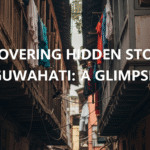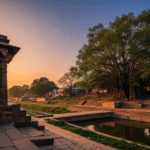Imagine a fort so vast it takes a long journey to see. Chittorgarh is about 312 km from Jaipur. It stands as a symbol of history and architecture. It is also close to Maharana Pratap Airport in Udaipur, just 90 km away. This fort attracts travelers and historians with its secrets and stories.
The Chittorgarh Fort is on a hill in the Mewar plains of Rajasthan. It shows the area’s rich past and fighting spirit. The fort has gates, palaces, temples, and towers. These tell stories of glory and bravery from India’s medieval times.
Even after many attacks, the fort’s spirit remains strong. It hides mysteries that the modern world is eager to explore. From fearless defenses to tales of unsung heroines, Chittorgarh Fort is a treasure trove of secrets. It is one of India’s most majestic forts.
Key Takeaways
- Chittorgarh Fort, a symbol of historical intrigue, stands 312 km from Jaipur and near Maharana Pratap Airport in Udaipur.
- The fort’s vast architecture reflects tales of courage and survival amidst the bustle of the medieval period.
- Chittorgarh Fort’s secrets contribute to its global allure, drawing in those fascinated by its legacy and mysteries.
- Rich in untold stories, the fort’s past is interwoven with the tribute and legends of its rulers and valiant women whose stories are lost in time.
- Modern-day pursuit of unraveling the Chittorgarh Fort historical secrets highlights an unwavering interest in the fort’s majestic past and enduring spirit.
Exploring the Origins of Chittorgarh Fort
The storied past of Chittorgarh Fort is full of legends. Its architecture shows India’s rich history. The fort is known for its strategic importance and innovative design. It tells many hidden stories.
The Founding Legend and Early Establishment
Legend says the Maurya rulers built the fort. But this is based more on stories than solid facts. This myth is key to understanding the fort’s valor. It sits on a 180-meter high hill, which protected it from invasions.
Architectural Innovations and Strategic Importance
The fort’s design was ahead of its time. For example, it had baoris (stepwells) for water during sieges. Its location was perfect for controlling trade routes. This added to its value. The fort’s defenses show great engineering and helped it survive many attacks over time.
| Feature | Details |
|---|---|
| Total Area | 700 acres |
| Height | 180 meters (Approx. 500 feet) |
| Main Attractions | Rana Kumbha’s Palace, Vijay Stambh, Kirti Stambh |
| Significant Temples | 19 Jain and Hindu temples including the Shanti Nath Jain Temple |
| Water Bodies | 84 historically, with 20 remaining including Gaumukh Reservoir |
The legacy of Chittorgarh Fort is still strong. It’s known for its stories of heroism and beautiful design. Exploring it means experiencing a key part of India’s history.
The Glorious Reign of the Mewar Dynasty
The Mewar Dynasty’s Chittorgarh Fort is a huge symbol of India’s past. It shows the bravery and strength of its leaders. This part talks about important events and the cultural growth at that time. It explains how Chittorgarh’s culture and leaders like Maharana Pratap made this fortress famous.
Notable Rulers and their Contributions
Maharana Pratap is a big name among Mewar’s leaders. His work went beyond just fights. He also made the fort bigger and showed his love for Mewar’s freedom. Born around 1540, his fight against the Mughals in 1576’s Battle of Haldighati is famous. Even though he had fewer men, he kept Mewar’s freedom spirit alive.
From 1585 to his death in 1597, Pratap worked hard to take back lands from the Mughals. Places like Udaipur and Kumbhalgarh came back under Mewar. He was great at fighting and never gave up. Maharana Pratap’s story still inspires many in India. A statue of him was placed in India’s Parliament in 2007.
Courtly Life and Cultural Patronage
The Mewar dynasty also cared a lot about culture. Chittorgarh Fort became a center for art, writing, and religion. The rulers held big festivals and rituals that made the place richer in culture.
The fort’s beautiful palaces and temples show how much they loved culture and spirituality. These places were where people talked about literature and religion. The rulers made sure culture and knowledge grew there.
| Event | Year | Details |
|---|---|---|
| Battle of Haldighati | 1576 | Maharana Pratap’s iconic battle against Mughals |
| Reclamation of Territories | 1585-1597 | Period during which Pratap reclaimed Udaipur, Gogunda, and other areas |
| Statue Unveiling | 2007 | Statue of Maharana Pratap unveiled in the Parliament of India |
Exploring Chittorgarh Fort shows us the Mewar Dynasty’s history. The stories of war and culture during this time are fascinating. This part of Chittorgarh’s story is very important. It attracts both historians and tourists.
Chittorgarh Fort: A Testament to Valor and Sacrifice
Chittorgarh Fort is one of India’s most legendary forts. It echoes with heroism and loss. This huge fort shows the Chittorgarh Fort valor and remembers the Sacrifices at Chittorgarh Fort. Every stone and wall here tells stories of courage and sadness.
The fort is famous for its historical sieges. Heroes like Alauddin Khilji and Emperor Akbar attacked it. The fort’s defenders chose honor over life. They did Jauhar—self-immolation to preserve their dignity.
The fort’s sad tales of bravery make it sacred. It’s a symbol of pride. People visit to admire it and think about the brave ones who lived there. Their courage still inspires many today.
In short, Chittorgarh’s story is remarkable. It’s about more than just a beautiful fort. It reminds us of the great lengths people will go to for their beliefs. The fort stands tall, symbolizing Rajput courage and sacrifice.
The Unsung Heroines of Chittorgarh
Chittorgarh Fort has amazing stories of brave warrior women. These women are central to the Fort’s legend of female heroism. They show the spirit and bravery that make the Fort’s history special.
Lives of Prowess: The Stories of Warrior Queens
The warrior queens of Chittorgarh, like the famous Rani Padmini, showed incredible bravery and leadership. Rani Padmini’s story is one of great sacrifice and strength during sieges. She led the way for women to resist and fight in history.
Many women in the Fort were not just wives and mothers. They were also smart tacticians and fighters. They showed great skill in battle and in planning during wars.
Mysteries Behind the Jauhar Rituals
The Jauhar rituals are among Chittorgarh’s most touching tales. Led by women like Rani Padmini, they chose death over dishonor by invaders. These moments of Jauhar show their strong will and choice. They blend honor, fear, and resistance beautifully.
These stories live on, inspiring awe for the bravery of these women. They remind us of the power and spirit of the women of Chittorgarh.
| Figure | Role | Legacy |
|---|---|---|
| Rani Padmini | Queen and Leader during Jauhar | Embodiment of bravery and purity in Rajput folklore |
| Meera Bai | Princess-Poetess | Spiritual legacy through devotion to Lord Krishna |
| Hadi Rani | Sacrificial heroine | Symbol of ultimate sacrifice and inspiration for the Hadi Rani Mahila Battalion |
The stories and Jauhar traditions show Chittorgarh Fort’s deep history. They highlight the important role of its women. These tales enrich our understanding of the past. They also inspire us with courage and sacrifice today.
Sieges and Struggles: Key Battles that Shaped the Fort’s Destiny
The Chittorgarh Fort has a rich history. It faced many Chittorgarh Fort sieges that were key. These battles helped shape the area’s culture and history. They showed the courage and smart plans of the fort’s defenders. Let’s explore three famous Chittorgarh’s storied battles.
| Year | Invader | Result | Impact on Chittorgarh |
|---|---|---|---|
| 1303 | Alauddin Khilji | Khilji Victory | Initiated a series of subsequent invasions and increased fortifications |
| 1535 | Bahadur Shah of Gujarat | Shah Victory | Massive reconstruction and military enhancement of the fort |
| 1567 | Akbar | Mughal Victory | Decreased Rajput control, leading to Mughal influence in the region |
Chittorgarh Fort saw many tough times. The first big siege in 1303 by Alauddin Khilji was brutal. But, the Rajputs defended bravely. This was the start of many Chittorgarh Fort sieges.
Later sieges by Bahadur Shah and Akbar changed the fort a lot. They made the fort stronger. This was to keep it safe from more attacks.
The Chittorgarh’s storied battles are key to understanding Rajput bravery against invaders. Every battle left a mark on the area. They also added to the rich stories of the local people.
The sieges’ stories are still alive in Chittorgarh today. Every part of the fort tells of bravery and strong will. This history is why Chittorgarh Fort stands as a symbol of Rajput pride. It remembers a fascinating but hard past.
Chittorgarh Fort’s Secret Tunnels and Hidden Passages
Beneath Chittorgarh Fort lie secret tunnels and hidden passages. These pathways were made from Rajasthan’s rugged land. They show the fort’s history of war and secret escapes. This allowed people to avoid enemies or bring in help silently.

The discovery of these tunnels has amazed historians and visitors alike. It’s like something from a suspense novel. But unlike fiction, these passages had real uses. They were used for royal escapes or to send messages during sieges.
The Intricate Network Below the Fort
The architects used the land to build a vast network of passageways. They twist beneath the fort, unseen by enemies above. This helped protect the fort in many battles. It made the fort known as unbeatable.
Theory and Legends Surrounding the Clandestine Routes
Legends add mystery to these underground routes. They tell of secret meetings and paths to far places. These stories make Chittorgarh’s tunnels even more intriguing. Archaeologists are learning more, but there’s still much to discover.
To learn more about India’s history and culture, check out West Bengal here. You can explore temples, lakes, and a mix of heritage and nature. It’s like uncovering Chittorgarh’s hidden stories.
The Legend of Mirabai and her Eternal Connection to Chittorgarh
Mirabai was a big part of the Bhakti Movement. She was born into a royal Rajput family in 1498. She loved Lord Krishna so much. She wrote poems and songs about her love for Him.
Mirabai was married to Prince Bhojraj from Chittorgarh. But her love was for Krishna, not just her prince. She faced lots of problems because of her love for God. But, she never stopped loving Krishna or writing about it.
Mirabai’s songs show her big love for Krishna. They also show Chittorgarh Fort as a special place. This place was strong but also full of love because of stories like Mirabai’s.
Chittorgarh Fort, with its impressive structure and its myriad legends, has stood the test of time, reflecting the enduring nature of Mirabai’s devotion.
Many people visit Chittorgarh Fort because of Mirabai. They want to see where she lived and prayed. They find her story very moving.
The fort today reminds us of Mirabai’s love and faith. It inspires those who hear her story. Her life and words touch many hearts, even today.
Archaeological Discoveries: Unearthing the Lesser-Known Facts of Chittorgarh
Recent work at Chittorgarh Fort has brought new stories to light. These finds tell us more about the fort’s history. Now, we can understand its past better.
Recent Excavations and Their Significance
The dig at Chittorgarh Fort found old relics and buildings. These discoveries are important. They show us the fort’s hidden history. We learn about how it was built, the crafts of the people, and their everyday lives. This helps historians and archaeologists fill in missing parts of its story.
Artifact and Inscriptions that Narrate Untold Stories
The latest finds include artifacts and writings. They tell us about the fort’s untold stories. These stories are about cultural connections, battles, and the rulers. Each artifact and writing connects us to the past. They help us understand the people who built and lived in the fort.
| Artifact | Description | Estimated Period |
|---|---|---|
| Coin Collection | Various coins from different eras depicting the economic history and trade links. | 5th-17th century CE |
| Pottery fragments | Decorated pottery pieces, signifying the domestic life and artistic pursuits within the fort. | 9th-16th century CE |
| Inscribed slabs | Stone slabs with inscriptions about victories and royal decrees. | 12th-15th century CE |
Mixing archaeology with history teaches us more about Chittorgarh Fort. This highlights its role in India and world history.
Secret history of Chittorgarh Fort
The storied past of Chittorgarh Fort blends reality and myth. It draws interest from those eager to learn about unraveling Chittorgarh’s history. In its depths, we find stories of bravery, sadness, and lasting mystery.

Forging the Legends: Myths vs. Historical Accounts
The tales of myths of Chittorgarh Fort often mix with true historical facts. This mix creates a fascinating story of legends and real events. It shows both heroism and actual historical battles and politics. This blending makes the fort’s story richer but also harder to separate fact from fiction.
The Enigma of the Unknown: Mysteries Yet to be Solved
Many parts of Chittorgarh Fort mysteries are still a puzzle. They interest both experts and visitors. The mysteries about unknown tunnels, the uses of architectural parts, and the full history keep everyone curious. Each unsolved mystery makes Chittorgarh even more enticing, pulling in more people to explore its secrets.
The effort to uncover unraveling Chittorgarh’s history is ongoing. It shows how much the world is intrigued by this legendary fort. Within its walls are tales of conflict and triumph, along with secrets from long ago. These are waiting to be completely discovered and understood through new research and ventures.
The Spiritual Side: Temples and their Ancient Rituals
The spiritual history of Chittorgarh Fort is easy to feel. Its temples and rituals breathe life into its stories. The fort shares tales of both battles and deep devotion.
Among the many Chittorgarh Fort temples, the Kalika Mata Temple is special. It’s known for its beauty and spiritual depth. Here, ancient rituals at Chittorgarh Fort bring people together in faith.
The Kumbha Shyam Temple is dedicated to Varaha, Lord Vishnu’s boar form. This temple shows the royal family’s close bond with their gods. The rituals here amaze both locals and tourists with their deep faith.
These temples help us understand the fort’s spiritual past. Visit this site for more. They’re not just places to pray; they’re keepers of history and culture.
The fort’s stones speak of devotion. It’s more than a military place; it’s a site of pilgrimage. With rich spiritual practices, Chittorgarh Fort is a living legacy of faith that inspires many.
Restoration Efforts and the Fort’s Present-Day Significance
The ongoing Chittorgarh Fort restoration efforts show deep respect for India’s history. They also show the challenges of preserving such monuments. The preservation of Chittorgarh Fort is key to keeping its structure and culture safe. It’s important for Chittorgarh’s heritage tourism.
These efforts use careful studies and old building ways. This makes sure repairs match the original design. The aim is to make the fort last longer while keeping its historic look and value.
Challenges in Preservation and Conservation
The team works hard to fix the fort’s old walls and towers. They make sure not to change their original look. Modern methods help check the fort’s condition. They help do repairs that don’t change much. The area’s tough weather also makes the sandstone wear down faster. This means more work is needed to keep things up.
Chittorgarh’s Role in Heritage Tourism and Education
The fort is a busy place for Chittorgarh’s heritage tourism. Lots of visitors come to see its big walls and learn its stories. They help the local money situation and get the community into keeping the heritage safe. Special learning programs at the fort teach about the area’s rich past. This builds pride and care among the locals. Through education, the fort’s tales and lessons are shared with new people. This keeps Chittorgarh’s legacy alive for all.
Conclusion
The journey through Chittorgarh Fort has revealed centuries of history. It shows India’s culture and history. The fort’s tales of bravery and spiritual stories are inspiring.
It tells of sieges, secret tunnels, and temple hymns. The fort’s design shows innovation and strategy. It shares stories of heroes and heroines. These stories are saved for the future.
The story of Chittorgarh Fort is not stuck in the past. Efforts to save the fort help us learn. They make us feel proud of our heritage. The fort’s story helps us understand India’s growth.
FAQ
What are some of the secrets associated with Chittorgarh Fort?
The Chittorgarh Fort hides many secrets. These include hidden passages and the true reasons it was built. Brave tales from the past also play a part in its mystery.
Who established Chittorgarh Fort, and when was it built?
Legend says the Maurya Dynasty built Chittorgarh Fort. It likely started in the 7th century. But the exact time is not clear.
How did the Mewar Dynasty contribute to the history of Chittorgarh Fort?
The Mewar Dynasty is known for its brave leaders like Maharana Pratap. They also supported arts and culture, expanding and beautifying the fort.
What is the significance of the sieges of Chittorgarh Fort?
The sieges show how tough the fort was against attacks. They remind us of the huge sacrifices made by defenders. Stories of sacrifice during attacks by leaders like Alauddin Khilji and Akbar stand out.
Who were the unsung heroines of Chittorgarh?
Heroines of Chittorgarh include Rani Padmini and Meera Bai. Their stories of bravery and devotion are linked to the fort. They are remembered for their courage and spiritual dedication.
Are there any secret tunnels in Chittorgarh Fort?
Yes, the fort has many secret tunnels. These were used for escape during sieges. Their full details remain a mystery, adding to the fort’s charm.
What archaeological discoveries have been made at Chittorgarh Fort?
Archaeologists have found many ancient items and ruins at the fort. These finds tell us about the fort’s long history and culture.
How do myths and legends affect the interpretation of Chittorgarh Fort’s history?
Myths and legends mix with true stories, shaping how we see the fort. Figuring out what’s real and what’s not remains a task for experts.
What are the spiritual aspects of Chittorgarh Fort?
The fort is known for its temples and rituals that have lasted for ages. These religious sites show the fort’s spiritual side and tradition.
How are the restoration and preservation of Chittorgarh Fort being managed?
The fort is cared for through detailed conservation. This balances keeping its history with using new ways to preserve it. Its significance in culture and education helps in keeping it safe for the future.










